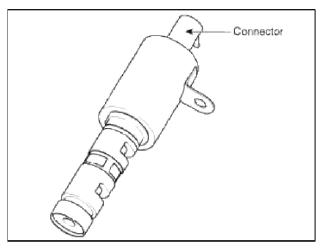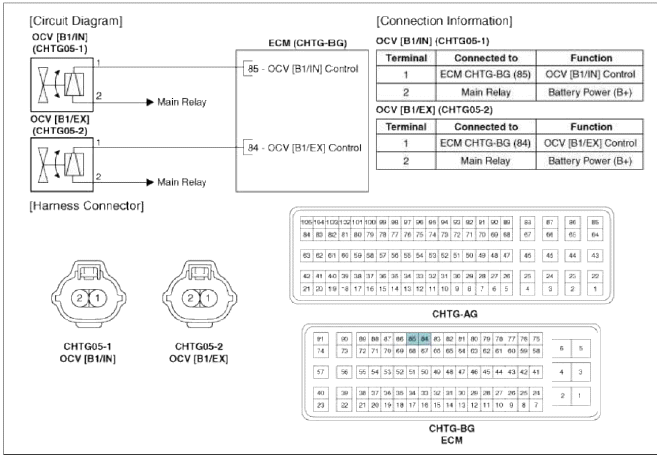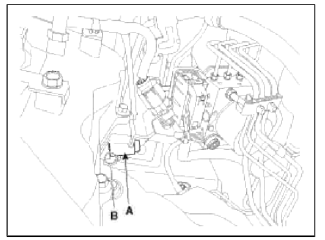Kia Sportage: CVVT Oil Control Valve (OCV)
Description and Operation
Description
Continuous Variable Valve Timing (CWT) system advances or retards the valve timing of the intake and exhaust valve in accordance with the ECM control signal which is calculated by the engine speed and load.
By controlling CVVT, the valve over-lap or under-lap occurs, which makes better fuel economy and reduces exhaust gases (NOx, HC) and improves engine performance through reduction of pumping loss, internal EGR effect, improvement of combustion stability, improvement of volumetric efficiency, and increase of expansion work.
This system consist of
- the CVVT Oil Control Valve (OCV) which supplies the engine oil to the cam phaser or cuts the engine oil from the cam phaser in accordance with the ECM PWM (Pulse With Modulation) control signal,
- the CVVT Oil Temperature Sensor (OTS) which measures the engine oil temperature,
- and the Cam Phaser which varies the cam phase by using the hydraulic force of the engine oil.
The engine oil getting out of the CVVT oil control valve varies the cam phase in the direction (Intake Advance/Exhaust Retard) or opposite direction (Intake Retard/Exhaust Advance) of the engine rotation by rotating the rotor connected with the camshaft inside the cam phaser.

Specifications
Specifications

Schematic Diagrams
Circuit Diagram

Repair procedures
Inspection
1. Turn the ignition switch OFF.
2. Disconnect the OCV connector.
3. Measure resistance between the OCV terminals 1 and 2.
4. Check that the resistance is within the specification.
Specification: Refer to "Specification"
Removal
[Bank 1 / Intake]
1. Turn the ignition switch OFF and disconnect the battery negative (-) cable.
2. Remove the OTS (A).
3. Disconnect the CVVT oil control valve connector (B).
4. Remove the installation bolt (C), and then remove the valve from the engine.
![[Bank 1 / Exhaust]](images/books/1921/22/index%2096.png)
[Bank 1 / Exhaust]
1. Turn the ignition switch OFF and disconnect the battery negative (-) cable.
2. Disconnect the CVVT oil control valve connector (A).
3. Remove the installation bolt (B), and then remove the valve from the engine.

Installation
CAUTION
- Install the component with the specified torques.
- Note that internal damage may occur when the component is dropped. If the component has been dropped, inspect before installing.
CAUTION
- Apply engine oil to the valve O-ring.
1. Installation is reverse of removal.
CVVT oil control valve installation bolt: 9.8 ~ 11.8 N.m (1.0 ~ 1.2 kgf.m. 7.2 ~ 8.7 lb-ft)
READ NEXT:
 Fuel Pressure Control Valve | Electric WGT Control Actuator
Fuel Pressure Control Valve | Electric WGT Control Actuator
Description and Operation
Description
Fuel Pressure Regulator Valve is installed on the high pressure fuel pump and controls fuel flow flowing into the injectors in accordance with the ECM si
 RCV Control Solenoid Valve | Canister Close Valve (CCV)
RCV Control Solenoid Valve | Canister Close Valve (CCV)
Description and Operation
Description
RCV (Recirculation Valve) Control Solenoid Valve is installed on the intercooler inlet pipe and operates the RCV actuator which controls the by-pass pass
SEE MORE:
 Turn Signal Lamp | Room Lamp
Turn Signal Lamp | Room Lamp
Repair procedures
Removal
Rear Turn Signal Lamp
1. Disconnect the negative (-) battery terminal.
2. Remove the rear bumper.
(Refer to BD group - "Rear Bumper")
3. Disconnect the connector. Remove the rear turn signal lamp (A) after loosening 5 screws.
4. Replace the bulb (A
 Theft-alarm stage
Theft-alarm stage
The alarm will be activated if any of the
following occurs while the system is
armed.
A front or rear door is opened without
using the smart key.
The liftgate is opened without using
the smart key.
The hood is opened.
The horn will sound and the hazard
warning lights will blink con
Content
- Home
- Kia Sportage - Fifth generation (NQ5) - (2022-2025) - Owner's Manual
- Kia Sportage - Second generation (JEKM) (2005-2015) - Body Workshop Manual
- Kia Sportage Third generation (SL) - (2011-2016) - Service and Repair Manual
- Sitemap
- Top articles